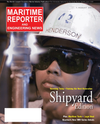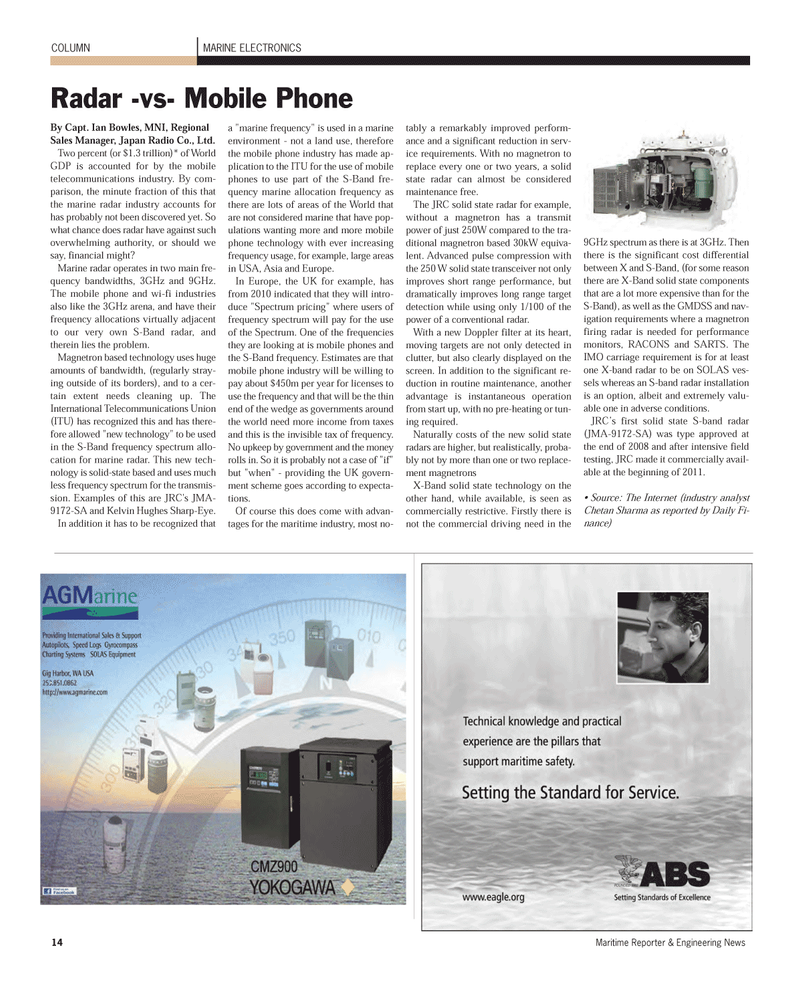
Page 14: of Maritime Reporter Magazine (August 2011)
Top 20 Shipyards of the World
Read this page in Pdf, Flash or Html5 edition of August 2011 Maritime Reporter Magazine
14Maritime Reporter & Engineering News MARINE ELECTRONICSCOLUMNBy Capt. Ian Bowles, MNI, Regional Sales Manager, Japan Radio Co., Ltd. Two percent (or $1.3 trillion)* of World GDP is accounted for by the mobiletelecommunications industry. By com- parison, the minute fraction of this thatthe marine radar industry accounts forhas probably not been discovered yet. So what chance does radar have against such overwhelming authority, or should we say, financial might? Marine radar operates in two main fre- quency bandwidths, 3GHz and 9GHz. The mobile phone and wi-fi industries also like the 3GHz arena, and have their frequency allocations virtually adjacent to our very own S-Band radar, and therein lies the problem. Magnetron based technology uses hugeamounts of bandwidth, (regularly stray- ing outside of its borders), and to a cer- tain extent needs cleaning up. The International Telecommunications Union (ITU) has recognized this and has there-fore allowed "new technology" to be used in the S-Band frequency spectrum allo- cation for marine radar. This new tech- nology is solid-state based and uses muchless frequency spectrum for the transmis- sion. Examples of this are JRC's JMA-9172-SA and Kelvin Hughes Sharp-Eye. In addition it has to be recognized thata "marine frequency" is used in a marine environment - not a land use, therefore the mobile phone industry has made ap-plication to the ITU for the use of mobilephones to use part of the S-Band fre-quency marine allocation frequency as there are lots of areas of the World that are not considered marine that have pop- ulations wanting more and more mobile phone technology with ever increasing frequency usage, for example, large areas in USA, Asia and Europe. In Europe, the UK for example, has from 2010 indicated that they will intro- duce "Spectrum pricing" where users offrequency spectrum will pay for the use of the Spectrum. One of the frequenciesthey are looking at is mobile phones and the S-Band frequency. Estimates are that mobile phone industry will be willing topay about $450m per year for licenses touse the frequency and that will be the thin end of the wedge as governments around the world need more income from taxes and this is the invisible tax of frequency. No upkeep by government and the money rolls in. So it is probably not a case of "if"but "when" - providing the UK govern- ment scheme goes according to expecta- tions.Of course this does come with advan- tages for the maritime industry, most no- tably a remarkably improved perform- ance and a significant reduction in serv- ice requirements. With no magnetron to replace every one or two years, a solid state radar can almost be consideredmaintenance free.The JRC solid state radar for example, without a magnetron has a transmitpower of just 250W compared to the tra- ditional magnetron based 30kW equiva- lent. Advanced pulse compression with the 250 W solid state transceiver not only improves short range performance, but dramatically improves long range target detection while using only 1/100 of thepower of a conventional radar. With a new Doppler filter at its heart, moving targets are not only detected in clutter, but also clearly displayed on the screen. In addition to the significant re- duction in routine maintenance, anotheradvantage is instantaneous operation from start up, with no pre-heating or tun-ing required.Naturally costs of the new solid state radars are higher, but realistically, proba- bly not by more than one or two replace- ment magnetronsX-Band solid state technology on theother hand, while available, is seen as commercially restrictive. Firstly there is not the commercial driving need in the 9GHz spectrum as there is at 3GHz. Then there is the significant cost differential between X and S-Band, (for some reasonthere are X-Band solid state componentsthat are a lot more expensive than for the S-Band), as well as the GMDSS and nav- igation requirements where a magnetron firing radar is needed for performance monitors, RACONS and SARTS. The IMO carriage requirement is for at leastone X-band radar to be on SOLAS ves- sels whereas an S-band radar installationis an option, albeit and extremely valu- able one in adverse conditions. JRC?s first solid state S-band radar (JMA-9172-SA) was type approved at the end of 2008 and after intensive field testing, JRC made it commercially avail- able at the beginning of 2011. Source: The Internet (industry analyst Chetan Sharma as reported by Daily Fi- nance)Radar -vs- Mobile PhoneMR Aug. 11 # 2 (10-17):MR Template 8/3/2011 9:47 AM Page 14

 13
13

 15
15
